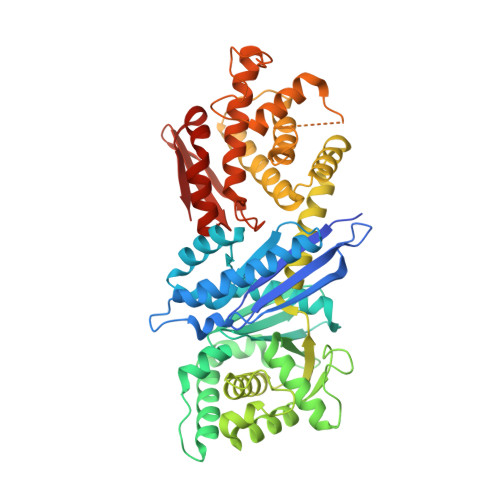Structural Evolution of Bacterial Polyphosphate Degradation Enzyme for Phosphorus Cycling.
Dai, S., Wang, B., Ye, R., Zhang, D., Xie, Z., Yu, N., Cai, C., Huang, C., Zhao, J., Zhang, F., Hua, Y., Zhao, Y., Zhou, R., Tian, B.(2024) Adv Sci (Weinh) 11: e2309602-e2309602
- PubMed: 38682481
- DOI: https://doi.org/10.1002/advs.202309602
- Primary Citation of Related Structures:
8JGO, 8JGP, 8JGQ, 8JGR, 8JGT, 8JGU, 8JGW, 8JGX - PubMed Abstract:
Living organisms ranging from bacteria to animals have developed their own ways to accumulate and store phosphate during evolution, in particular as the polyphosphate (polyP) granules in bacteria. Degradation of polyP into phosphate is involved in phosphorus cycling, and exopolyphosphatase (PPX) is the key enzyme for polyP degradation in bacteria. Thus, understanding the structure basis of PPX is crucial to reveal the polyP degradation mechanism. Here, it is found that PPX structure varies in the length of ɑ-helical interdomain linker (ɑ-linker) across various bacteria, which is negatively correlated with their enzymatic activity and thermostability - those with shorter ɑ-linkers demonstrate higher polyP degradation ability. Moreover, the artificial DrPPX mutants with shorter ɑ-linker tend to have more compact pockets for polyP binding and stronger subunit interactions, as well as higher enzymatic efficiency (k cat /K m ) than that of DrPPX wild type. In Deinococcus-Thermus, the PPXs from thermophilic species possess a shorter ɑ-linker and retain their catalytic ability at high temperatures (70 °C), which may facilitate the thermophilic species to utilize polyP in high-temperature environments. These findings provide insights into the interdomain linker length-dependent evolution of PPXs, which shed light on enzymatic adaption for phosphorus cycling during natural evolution and rational design of enzyme.
Organizational Affiliation:
Institute of Biophysics, College of Life Sciences, Zhejiang University, Hangzhou, 310029, China.


















